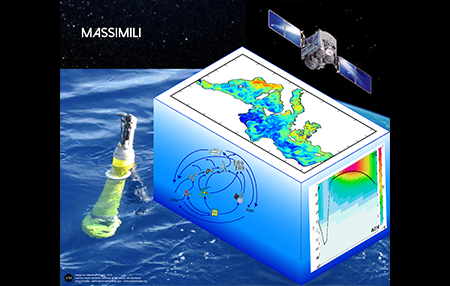In the frame of the continuous improvement strategy of the Copernicus Marine Service, OGS and LOV won a tender (issued by Mercator Ocean) that supports a 2-year project on leading Science and Technological development, aimed at ensuring the evolution of the service and being potentially implemented operationally within 3 years.
The target of the project MASSIMILI is the development of a multi-data assimilation scheme to integrate Bio-Argo floats data with Ocean Colour satellite data into the biogeochemical modelling systems of the CMEMS Monitoring and Forecasting Centres.
Compared with physical observations (e.g. temperature, salinity, current), biogeochemical data (chloropyhll, organic and inorganic nutrients, biomass) are quite scarce in the world ocean. Satellites may observe the light properties of the ocean surface (ocean colour) and give an estimate of the chlorophyll, but their measure is only 2-dimensional, and often limited by the cloud cover. The ocean properties are inherently 3-dimensional, and only specific buoys called floats, which are designed to follow the deep currents, are able to give information on the vertical dimension. Argo is the international program that maintain operational the float network of more than 3,000 free-drifting profiling floats that measures the physical and biogeochemical properties of the upper 2000 m of the ocean, allowing a continuous monitoring of the upper ocean, with all data being relayed and made publicly available within hours after collection.
The Mediterranean Sea is a perfect laboratory for the implementation of the multi-data assimilation: the higher density of Bio-Argo floats (i.e. floats specifically designed to measure biogeochemical quantities as chlorophyll, nitrates and dissolved oxygen) is coupled with a low cloud cover (and thus a high availability of ocean colour data) and with the most advanced operational modelling system able to assimilate the satellite data, the 3DVAR-OGSTM-BFM managed by OGS within the Mediterranean component of the Copernicus Marine Service (CMEMS-Med-MFC).
The main steps of MASSIMILI are:
- Qualification of the multi-data and multivariate biogeochemical datasets (Bio-Argo and ocean colour) to be used by the assimilation scheme.
- Development of the numerical components of a new multi-data scheme which assimilates chlorophyll, nitrate and oxygen in the frame of the 3DVAR variational scheme already implemented in the biogeochemical component of the CMEMS MED-MFC.
- Assessment of the impacts of the new multi-data assimilation scheme to the CMEMS biogeochemical products following a protocol of different tests, by adopting new skill performance metrics specifically developed in the project to validate the multi-data assimilation with selected observational datasets.
The activities of MASSIMILI will benefit the users by increasing the quality of the CMEMS biogeochemical products with a better quantification of the model errors, also contributing to the capacity building for CMEMS TACs and MFCs involved in biogeochemical multi-data use and assimilation and providing feedback/suggestions on the efficiency/performances of the existing and future Bio-Argo networks.
